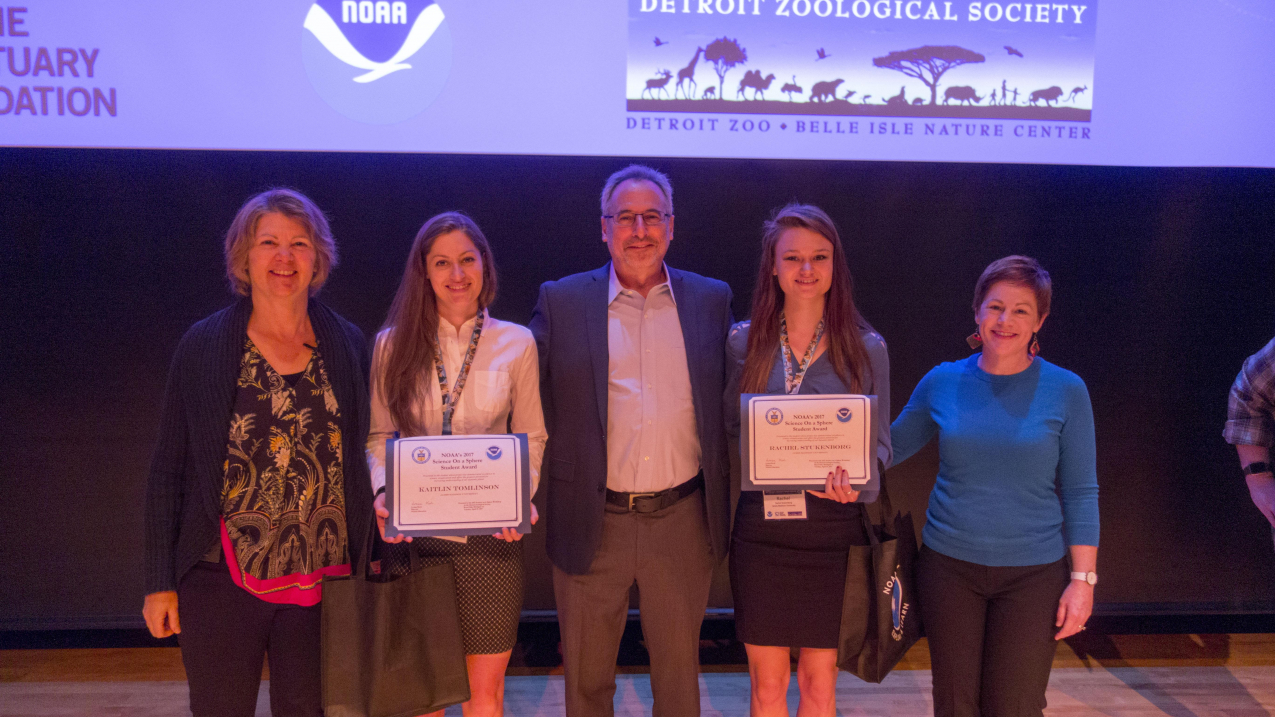With over 130 institutions worldwide using NOAA’s Science On a Sphere® (SOS), the platform provides unparalleled opportunities for global data visualization. However, teachers and students have not taken full advantage of this resource. To help close this gap, NOAA's Office of Education and NOAA Research launched a student contest for the 2017 Science On a Sphere Users Collaborative Network Workshop at the Detroit Zoo on April 25–27, 2017.

Kaitlin Tomlinson and Rachel Stukenborg won the inaugural Science On a Sphere student contest for their datasets and lesson plans focusing on energy poverty. From left to right: Louisa Koch, Director of NOAA Education; Kaitlin Tomlinson, James Madison University; Ron Kagan, CEO and Executive Director of Detroit Zoo; Rachel Stukenborg, James Madison University; and Carrie McDougall, NOAA Education. (Image credit: Detroit Zoo)
Part of the 10th anniversary of the SOS Network, the contest aimed to engage students and their teachers with NOAA science and SOS. Kindergartners through college students were invited to create new maps, visualizations, and stories that help share NOAA’s mission in creative and innovative ways.
The winners of the contest were Rachel Stukenborg and Kaitlin Tomlinson of James Madison University. Their project, “Energy Poverty-SOS: The overarching problem of energy poverty,” exemplified the thoughtful and innovative approach NOAA sought to encourage through the contest. Energy Poverty is the lack of access to the modern energy services of electricity and clean cooking facilities, which affects 1.4 billion and 2.7 billion people, respectively.
The purpose of their senior capstone project at James Madison University in the Department of Integrated Science and Technology was to develop a set of university-level teaching and learning resources about energy poverty that incorporate the Sphere. At the workshop, Tomlinson and Stukenborg presented four separate lesson packages about energy poverty. The first three explored the nature and consequences of energy poverty, while the fourth delves into the social, political, economic and cultural dynamics of sustainable solutions. Each lesson package includes a background analysis, a lesson plan, supporting teaching and learning resources, and a SOS dataset.
We thoroughly enjoyed meeting all of the like-minded people, participating in the conference, having the opportunity to share our work with the community, as well as getting the chance to visit Detroit.
Rachel Stukenborg and Kaitlin Tomlinson, James Madison University
Stukenborg and Tomlinson were invited to present their project at the Workshop, all expenses paid. There, they presented the learning resources and sphere datasets of “Nighttime Lights” and “Population Density” to demonstrate how global poverty and energy poverty are related. They each also received an award certificate from NOAA, a $125 Amazon gift certificate to be used on educational products, and an “all-hazards” NOAA weather radio. These awards were supported by our partner for this contest, the National Marine Sanctuary Foundation.
Ultimately, the new datasets and associated learning resources will be added to the SOS Dataset Catalog for more than 130 member institutions to use. The Science On a Sphere Network members hope to use contests like this to continue to inspire students and teachers to learn about and use data visualization as a way to convey scientific concepts.
This story was provided by the Office of Education and NOAA Research, members of the NOAA Education Council, as part of our ongoing effort to share education accomplishments from across NOAA.



